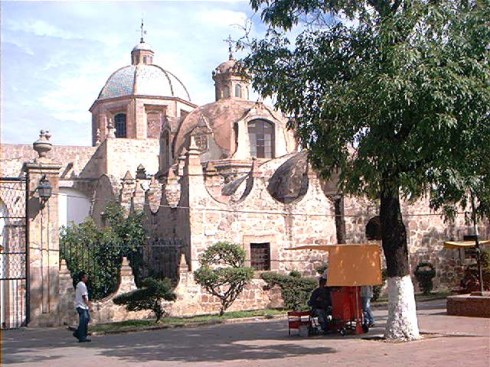
Download to your phone, tablet, laptop on Amazon.com, Amazon.com.mx; Barnes and Noble.com; Kobo.com (now includes sony Readers) and on Google Play. Search William J. Conaway.
History and Walking Tours of Morelia, the City of Music
Copyright William J. Conaway, 1999, Derechos Reservados
Morelia’s love for Order and Vast Spaces bears the Stamp of the Renaissance Spirit
Morelia, the capital of the State of Michoacán, known, during the Spanish Colonial period, as Valladolid is located in the Guayangareo valley at 6,368 feet above sea level. It’s 195 miles west of Mexico City and 228 miles Southeast of Guadalajara. Morelia has a population of approximately 500,000 people at this writing, an important intellectual and artistic center for the entire region.
The Guayangareo valley was swamp land and there was a constant battle against malaria of its inhabitants until finally in 1939, the Contzio dam was built and the swampland drained.
The ancient volcano of Quinceo is responsible for the configuration of the valley and the city is surrounded by the mountains of Santiaguito, Santa María de la Asunción, and a towering wall of pink cantera stone with which much of the cities buildings were adorned.
Fray Juan de San Miguel is credited for the discovery of the valley for the Spaniards. He erected a chapel, on May 18, 1531, dedicated to San Francisco which initiated the construction of Valladolid. (The chapel became the Church and Convent of San Francisco that we will see later.)
The lay-out of the city was designed by the master mason, Juan Ponce in 1543. The designation as a city and the coat of arms came from Carlos V, in 1545 and 1553 respectively. It remained a relatively small city until the civil powers and the Episcopal See were moved there from Pátzcuaro in 1579.
The first settlers were Luis Dávila, of Seville; Juan Pantoja and Domingo de Medina, of Medellín; Luis Calero, of Palos de Moguer; Pedro Moreno and Gregorio de Aviña, of Galicia; Juan Alvarado, of Bandajoz; and Francisco Moreno, of Aragón, Spain.
Their characteristic regionalism was forgotten in the New World and these Spanish families gave birth to Criollos, sons and daughters born in Nueva España. One particular encomendero of Michoacán, Juan Villaseñor Orozco, founded the families of Miguel Hidalgo y Costilla (father of México) and Agustín Iturbide (first emperor of México).
The Spaniards followed the ancient Indian trails through the region known as Mil Cumbres, Thousand Pinacles, 315 kilometers to get there. This forested, mountainous area is characteristic of much of the State. On this modern day highway that follows the original route you will see valleys that range from cold, to warm, to hot lands and back again. This difficult route kept Morelia isolated from the rest of the country for much of its history with a few notable exceptions.
The first Viceroy, Vice-King, Don Antonio Mendoza, sent from Spain was amazed at the arts and crafts of the Indian inhabitants of Michoacán. The crucifixes made of reeds and the gold filigreed lacquered trays, bowls, and plates became famous all over Europe. Mendoza also met with the chiefs who were adorned with robes decorated with hummingbird feathers, obsidian or turquoise earrings, and tiaras of gold or silver. So colorful and beautiful were they and their women that Mendoza ordered a study be written of their culture, rites, and religion, “Relación de las Ceremonias y Ritos y Población de los Indios de la Provincia de Mechuacán.”
The early years of Valladolid belong to the clergy, there were so many churches and convents (in 1738 there were 40 convents). The ever-present sound of bells called the people to prayer, announced grief, or joy.
Tags: Juan Alvarado, Juan Pantoja, Mexico, Mexico Walking Tours, Morelia, Renaissance Spirit Morelia, Valladolid, William J. Conaway.










